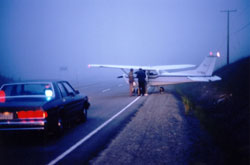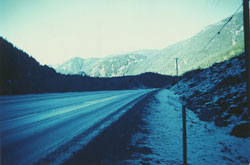Several factors can contribute to the likelihood of a pilot becoming spatially disoriented. There is usually an element of surprise and unpreparedness as the VFR pilot stumbles into instrument conditions. Fatigue and distraction will render him/her less vigilant to external visual cues of deteriorating conditions. Anxiety can rapidly escalate to a panic state when the outside world disappears. With panic goes any semblance of problem solving - key to survival. Alcohol consumption is still found as a culprit after the dust and smoke have settled. It impairs judgement, concentration and coordination required to maintain aircraft control in IMC. Even the hangover state can last several days after binge drinking with impairment of the vestibular apparatus, resulting in unpredictable vertigo, nausea and vomiting. Several years ago one of my favourite Fleet Canucks, CF-DPN, was lost along with the lives of a young student pilot and his friend. The accident occurred at night with low ceiling and visibility. In their car was found a partially consumed bottle of hard liquor! The student had ceased training due to a medical condition. The aircraft was removed without permission and one of the occupants was not wearing a seat belt or it failed on impact - a stacked deck with disorientation holding the “winning hand”.
The common cold or upper respiratory tract infection can lead to distraction with pain from pressure changes in the middle ear or sinuses. The unpredictable onset of intense vertigo with inner ear involvement would result in instantaneous incapacitation (Type III spatial disorientation). Lack of current instrument training may lead to a false sense of security when instrument conditions are encountered. In these conditions, the VFR pilot struggles to maintain control. The current IFR pilot has demonstrated his/her ability to maintain control, recover from unusual attitudes, navigate, communicate, deal with instrument failures, aircraft emergencies, enter and fly a holding pattern, maneuver to minimums on an instrument approach, and fly to an alternate airport in IMC. Without currency training, these skills rapidly deteriorate.
With a flight condition having such a high fatality rate, insight, avoidance and prevention are key to longevity in aviation as a recreational pastime or career. Weather smarts with sound decision-making in the go/no go scenario are critical survival tools. The accident chain is broken when the decision to abort or divert a flight is made before IMC is encountered. A VFR pilot receiving a briefing of marginal VFR or IFR conditions for the intended route or an en route update of unforecasted deterioration at destination, is well advised to stay on the ground or press plan B into action. Every airborne pilot should have a plan B. Keep in mind it is always safer to land an aircraft under some semblance of control. The picture of the Cessna 172 on the Hope-Princeton Highway epitomizes the off airport landing. (Illustration 25 & 26). Caught between cloud layers just east of the Hope Slide, the pilot made the best of a tough situation landing under control on the highway. The flashing lights of the RCMP cruiser and illuminated navigation lights and anti-collision beacon are indicative of the adrenalin levels involved. The other photo shows that the pilot would have been playing Russian Roulette with mountainous terrain, in a 360 degree radius, had he pressed on.
“Gethomeitis” is a term that often comes into play with spatial disorientation accidents. It refers to the psychological pressure perceived by the pilot. It may be externally or internally applied. Whenever there is an urgency to complete a flight for personal or business reasons, and you start to lower your personal weather limitations - beware! The next link in the accident chain is this statement, “Let’s take off and have a look, we can always come back to the airport” - CLANG - the trap is set! Once airborne, IMC may be encountered in the climb out and the safe sanctuary of the departure runway vanishes. I refer to this mind-set as the Horniness Index or the Testosterone Factor. For some reason, this accident sequence is more prevalent in young male pilots. Remember it is always safer to be on the ground wishing you were in the air than vice-versa.
If at all possible, fly towards a confirmed natural horizon, avoiding cloud banks, mountains and water surfaces with indefinite horizons or surface features. Visual illusions may lead to inadvertent cloud penetration or a C.F.I.T. accident. If in doubt of visual clues, resort to the “180° Rule” and reverse course to better weather and positive visual references. This is much safer than pushing on until outside reference is lost.
When I obtained my private pilot’s license instrument flying was not included in the syllabus. Now it is, as well as with the night rating and commercial license. This experience provides the pilot with the ability to fly straight and level, recover from unusual attitudes, turn 180° and perhaps penetrate a thin cloud layer - that’s it! This skill is maximal at the time of the flight test and rapidly deteriorates thereafter if not practiced. During my early instrument training I was not introduced to the helpless sensation of spatial disorientation. On a recent IFR training flight, my keen young instructor, Andrew Soltau, provided two graphic demonstrations. After one hour of hood time flying approaches into Abbotsford, he informed me that we were going to do something different. The medical resident plugged into the back seat intercom was witness to my performance. The first demonstration was for me to fly straight and level with the hood on while looking at the cockpit floor. Using the sunlight and other senses I did quite well. After several minutes Andrew told me to look up and reorient myself. Not bad, down several hundred feet and 20 degrees off my original heading. My bubble burst when Andrew informed me that I had completed a 380 degree turn. Incredible, but the grinning resident in the back seat affirmed Andrew. The second demonstration was more graphic and came to a rapid conclusion. Andrew’s instructions were simple. - With the hood off, close your eyes and open them when you know you have lost control. My estimate was 15 seconds before the engine’s shrill pitch and air frame vibration signaled the increasing spiral dive. Opening my eyes I saw only earth - no sky, no horizon. After recovery there was no need to glance back at the resident. I would recommend these humbling demonstrations to any candidate - student to IFR, who has not experienced the sensation of spatial disorientation. It goes without saying that a safety pilot or instructor is essential!
A current instrument rating is good insurance against a disorientation accident but not a guarantee. Several scenarios come to mind of IFR drivers coming to grief. A typical example is a non-precision approach with circling procedure. During the circle to land visual reference is lost but the pilot pushes on in low level I.M.C. rather than carrying out the missed approach procedure. The fatal Metroliner accident in Terrace, BC highlights the risk involved. During night operations, the risk of circling procedures goes up almost exponentially! IFR pilots are also prone to C.F.l.T.(Type I) accidents. The cause may be a simple oversight such as failing to set the altimeter before commencing the approach or identify a navigational aid. The former resulted in the loss of a Medevac Lear jet in the chilly waters near Massett, BC. There were no survivors among the flight crew or medical personnel . On an IFR flight test there are several critical safety checks which if omitted will result in automatic failure. In the real world of IMC similar omissions can have dire consequences! Since obtaining an IFR rating in 1989 I have managed to minimize the adrenaline rush experiences of spatial disorientation. My personal limits are well above those in the Canada Air Pilot and I have a total aversion to freezing rain and thunderstorms.

